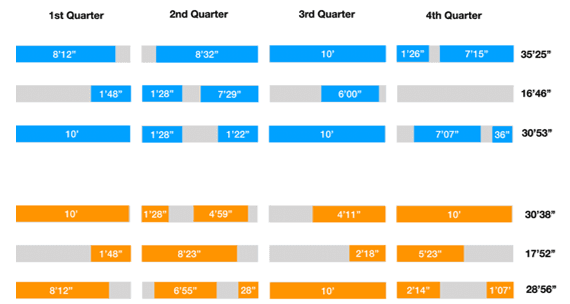Authors: Francesco Cuzzolin, Jaime Sampaio, Julio Calleja-González, Igor Jukic, Baris Kocaoglu, Mar Rovira, Antonio Santo.
Basketball games have evolved into fast-paced and intense contests, necessitating constant adaptations in training methodologies and coaching decisions. The game’s pace is evident in every aspect from rapid transitions between offense and defense, tactical adjustments, and foul calls, to interruptions for substitutions, timeouts, and video reviews, which provide opportunities for rest and strategic preparation for the next phase of play. Players now assume more versatile roles [1] than those defined by traditional court positions and demonstrate impressive levels of physical and cognitive fitness. Prolonged game time for key players is often necessary to achieve competitive success in leagues like the NBA or EuroLeague. However, emerging evidence suggests that over-utilizing players can decrease performance and increase injury risk, particularly when games are densely scheduled, and recovery time and training opportunities are very limited [2]. A hectic schedule not only increases the competitive load but also adds the heavy burden of frequent travel, leaving little time for adequate recovery training – factors critical for sustaining performance and minimizing injury risks. It is unsurprising that prolonged minutes, especially for key players, heighten musculoskeletal stress and fatigue, impair neuromuscular function, and elevate the likelihood of overuse injuries, acute strains, and chronic conditions. Managing these risks requires detailed analysis of player individual workloads and targeted strategies to balance performance with long-term health.
Total Minutes and Prolonged Minutes
Competitive player workload can be roughly analyzed using Total Minutes (TM) — cumulative time on the court — and Prolonged Minutes (PM) — uninterrupted play periods.
Figure 1 illustrates TM distribution by age groups in the 2024/2025 EuroLeague season thus far. The diversity in TM across age groups challenges coaching staff to balance workloads between young prospects and veterans while maintaining performance.

Figure 1. Distribution of total minutes (TM) per age group: results from all players participating in the 2024/2025 season of the Euroleague.
Although individual tolerance varies, research shows that cumulative fatigue from back-to-back games or excessive TM is strongly correlated with increased injury rates. A study by Lewis (2018) highlighted that increased game density and cumulative playing time are significant predictors of injury incidents in the NBA [3]. Specifically, injury odds were found to rise by 3% for every additional 96 minutes played and decrease by 16% for each additional day of rest. Although there is no one-size-fits-all number because every basketball game is essentially unique withthe competition constraints being multifactorial and changingacross the game story [4], there should be an optimal balance between involvement in competition, practice exposure and time for recovery [5].
Optimizing Playing Time
Key factors influencing effective playing time managementinvolve consideration of key elements like:
• Player roles: some players experience fatigue due to frequent accelerating and decelerating demands, while other players experience fatigue due to position fights;
• Injury history: players with past injuries need tailored workload management.
• Schedule density: “back-to-back” games require extra caution to prevent cumulative fatigue.
• Fitness peak: players at their fitness peak can perform at higher intensity, sustain effort longer, and recover faster, allowing for more efficient use of their minutes on the court.
Strategies such as rotating lineups, using wearable technology for data-driven decisions, and incorporating subjective feedback (e.g., RPE) can help to optimize performance and minimize injury risk. Research and practice in elite basketball suggests that shorter stints of 6–8 minutes, followed by breaks, can help to maintain high performance levels while managing fatigue. Prolonged play (e.g., over 8–10 consecutive minutes) leads to a decline in neuromuscular control and decision-making. Considering the high intensity of the game [6], dividing TM into shorter, manageable slots with breaks is generally better for reducing fatigue and injury risk compared to prolonged minutes in a row. Alternating shorter bursts of effort with brief recovery periods allows the player to regain some neuromuscular efficiency, hereunder the main advantages:
• Energy System Recovery: Basketball heavily relies on anaerobic energy systems for high-intensity bursts. Studies [7] indicate that shorter rotations enable players to replenishphosphocreatine stores, which are essential for sustaining repeated sprints and jumps.
• Cognitive Recovery: Frequent substitutions help alleviate cognitive load and mental fatigue caused by prolonged focus, particularly during high-stakes games.
• Performance Maintenance: Research in team sports [8] shows that players can sustain higher levels of speed, power, and decision-making with short breaks, leading to better overall performance during crucial moments.
Figure 2 presents data extracted from six players who participated in a Euroleague game, showing the diversity of PMs, that can range from few seconds to a whole quarter, with several cases exceeding the 6-8 minutes intervall.

Figure 2. Distribution of prolonged minutes (PM) of 6 players during an Euroleague game.
Implementing Rotational Strategies in Practice
To integrate shorter playing stints into a team’s routine, performance specialists can combine real-time monitoring with strategic planning to help coaching staffs manage players effectively. Here’s a simplified guide:
1. Monitor Player Load and Fatigue
Wearable technology tracks player workload, providing valuable data to optimize management and make informed and consensued decisions.
2. Set Pre-Game Rotation Plans
Plan substitutions based on player roles and opponent strength. Rest key players early to save them for critical moments.
3. Communicate with Players
Explain the benefits of rotations, focusing on performance, injury prevention, and career longevity.
4. Use Timeouts and Breaks Wisely
Maximize recovery by timing substitutions with natural stoppages, like timeouts.
5. Adjust Based on Game Flow
Be flexible with substitutions. Adapt to game situations, such as foul troubles or momentum shifts, to manage fatigue while keeping players engaged.
CONCLUSION
Optimizing individual playing minutes is not just about managing fatigue, it’s about sustaining team performance, preventing injuries, and preserving player longevity. A proper management ofplaying time has significant short-term and long-term effects. In the short term, it impacts game performance, while in the long term, it reduces the risk of potential fragilities, injuries, and the progressive decline in performance.This is why elite teams must adopt a multidisciplinary approach, combining load monitoring with subjective feedback to fine-tune substitution patterns. Ensuring that players are rotated before fatigue affects their performance or increases injury risk is essential. The Performance Team and Coaching Staff must work closely to develop strategies tailored to their specific context, blending experience with data-driven insights to achieve optimal results.
References
1. Chen R. et al (2023), “Modeling the influence of basketball players’ offense roles on team performance” – Front Psychol. 8;14.
2. Calleja-González J et al (2016) “Evidence-based post-exercise recovery strategies in basketball”– Phys Sportsmed: 74-8.
3. Lewis, M. (2018) “It’s a Hard-Knock Life: Game Load, Fatigue, and Injury Risk in the National Basketball Association” – Journal of Athletic Training 53(5): 503–509.
4. Gomez M.A. et al (2016) “Exploring the effects of substituting basketball players in high-level teams” – Journal of Sport Sciences.
5. Capaross, T. et al (2016) “The Relationship of Practice Exposure and Injury Rate on Game Performance and Season Success in Professional Male Basketball“ – Journal of Sports Science and Medicine: 15, 397-402.
6. Petway A J, et al (2020) “Training load and match-play demands in basketball based on competition level: A systematic review” – PLoS ONE 15(3): e0229212.
7. Gabbett, T. J. (2016) “The Training-Injury Prevention Paradox: Should Athletes Be Training Smarter and Harder?” – British Journal of Sports Medicine, 50: 273–280.
8. Spooner, T. W. (2023) “Effect of Substitution Time on Physical, Technical and Cognitive Performance”– International Journal of Exercise Science, 16(6): 497-512.






